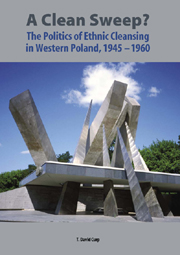Book contents
- Frontmatter
- Contents
- Acknowledgments
- Introduction: Hearts and Minds and Land: Ethnic Cleansing and the Stabilization of Postwar Poland
- 1 How the East Was Lost: Germany's Struggle for the Polish-German Borderlands, 1870–1945
- 2 Who Won the West: The Colonists and Ethnic Cleansers of Poznań and Eastern Brandenburg in 1945
- 3 Acts of Sacrifice: Poland's Ethnic Cleansing and the End of Political Pluralism, 1945–47
- 4 Counterrevolution from Above and Abroad: The Delocalization of Politics and the Beginning of Polish Stalinism's Antinational Counterrevolution, 1947–49
- 5 Waging Counterrevolution: The Party-State's Struggle for Hearts, Minds, and Land in Wielkopolska, 1949–53
- 6 Revolutions before the Revolution: National Solidarity and the Long Retreat of Stalinism in Wielkopolska, 1953–56
- 7 The Revolutions Betrayed? The Poznań Revolt and the Polish Road to Nationalist Socialism, 1956–60
- Conclusion: A Near Run Thing From National Solidarity to Solidarity
- Abbreviations
- Notes
- Bibliography
- Index
2 - Who Won the West: The Colonists and Ethnic Cleansers of Poznań and Eastern Brandenburg in 1945
Published online by Cambridge University Press: 12 September 2012
- Frontmatter
- Contents
- Acknowledgments
- Introduction: Hearts and Minds and Land: Ethnic Cleansing and the Stabilization of Postwar Poland
- 1 How the East Was Lost: Germany's Struggle for the Polish-German Borderlands, 1870–1945
- 2 Who Won the West: The Colonists and Ethnic Cleansers of Poznań and Eastern Brandenburg in 1945
- 3 Acts of Sacrifice: Poland's Ethnic Cleansing and the End of Political Pluralism, 1945–47
- 4 Counterrevolution from Above and Abroad: The Delocalization of Politics and the Beginning of Polish Stalinism's Antinational Counterrevolution, 1947–49
- 5 Waging Counterrevolution: The Party-State's Struggle for Hearts, Minds, and Land in Wielkopolska, 1949–53
- 6 Revolutions before the Revolution: National Solidarity and the Long Retreat of Stalinism in Wielkopolska, 1953–56
- 7 The Revolutions Betrayed? The Poznań Revolt and the Polish Road to Nationalist Socialism, 1956–60
- Conclusion: A Near Run Thing From National Solidarity to Solidarity
- Abbreviations
- Notes
- Bibliography
- Index
Summary
… all of society is caught up in a hatred of Germany … [this] creates a serious possibility of uniting all of society into one entire national front.
—Władysław Gomułka, in a paper “A New Situation—New Tasks” presented to an enlarged Plenum of the Central Committee of the Polish Workers Party on February 6, 1945The ethnic cleansing and territorial reconfiguration of postwar Poland was a vast undertaking. It involved expelling millions of Germans who remained east of the Oder-Neisse line, in spite of the mass flight of the majority of the population in the last months of the war. In their place, the Polish state sought to settle millions of former slave laborers and colonists, as well as Polish expellees from the Kresy, while sorting through another million citizens of the Third Reich who claimed to be of Polish descent. Most of this work had to be carried out while integrating over 115,000 square kilometers of devastated formerly German territory into the new Polish state and reintegrating a further 91,000 square kilometers of prewar Polish territory that had been incorporated directly into Nazi Germany for almost five years. Carrying this out in a politically divided, war-ravaged country required Poles to cooperate with each other and with international authorities. This was difficult, as the distance separating most Poles from the Soviet-imposed Communist regime that ruled over them was wide—and growing wider—in 1944 and 1945.
- Type
- Chapter
- Information
- A Clean Sweep?The Politics of Ethnic Cleansing in Western Poland, 1945–1960, pp. 34 - 54Publisher: Boydell & BrewerPrint publication year: 2006



